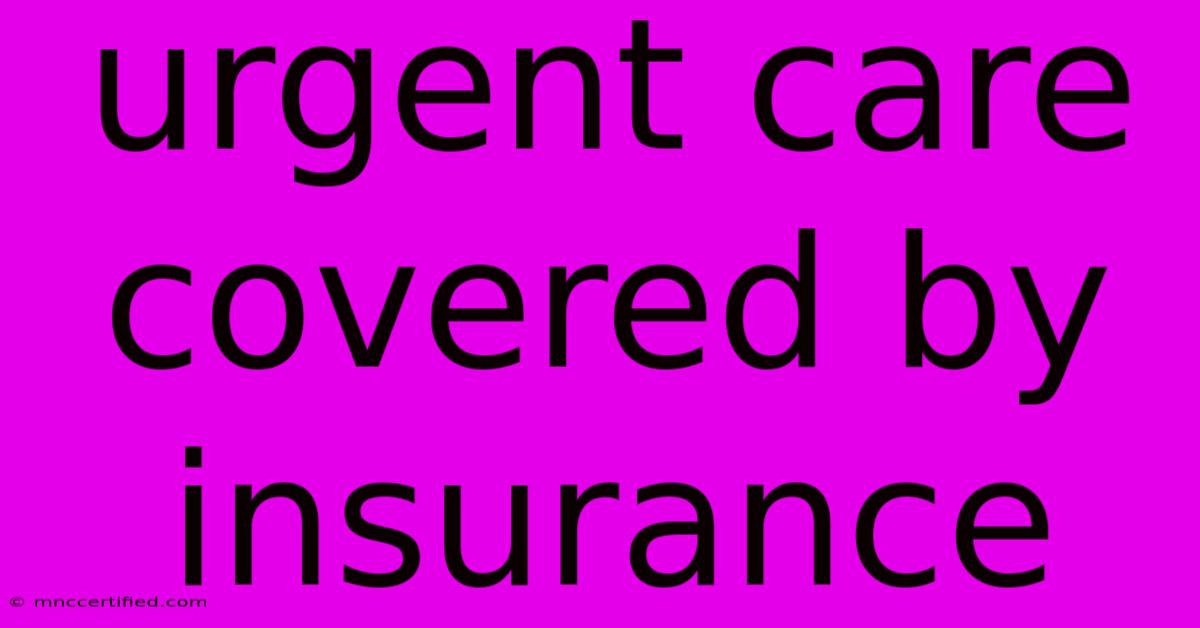Urgent Care Covered By Insurance

Table of Contents
Urgent Care Covered by Insurance: What You Need to Know
Navigating the healthcare system can be confusing, especially when faced with an unexpected illness or injury. Knowing whether your urgent care visit will be covered by insurance is a top priority. This comprehensive guide will help you understand the intricacies of insurance coverage for urgent care, empowering you to make informed decisions and avoid unexpected medical bills.
Understanding Urgent Care vs. Emergency Room
Before diving into insurance coverage, it's crucial to differentiate between urgent care and the emergency room (ER). Urgent care centers treat non-life-threatening conditions like:
- Minor injuries (sprains, cuts, burns)
- Illnesses (colds, flu, ear infections)
- Rashes and allergic reactions
- Stitches for minor wounds
Emergency rooms, on the other hand, handle life-threatening situations such as:
- Severe injuries (broken bones, deep wounds)
- Heart attacks
- Strokes
- Severe allergic reactions
Choosing the right setting is crucial for both your health and your wallet. Using the ER for non-emergency situations can lead to significantly higher costs, even with insurance.
Insurance Coverage for Urgent Care: Key Factors
Whether your urgent care visit is covered depends on several key factors:
1. Your Insurance Plan:
- PPO (Preferred Provider Organization): PPO plans generally offer broader coverage, including out-of-network urgent care centers, though you'll likely pay a higher cost-share. Always check if the urgent care center is "in-network" for better rates.
- HMO (Health Maintenance Organization): HMO plans typically require you to see doctors within their network. Urgent care centers must be in-network for coverage. Check your plan's directory for participating facilities.
- EPO (Exclusive Provider Organization): Similar to HMOs, EPO plans restrict care to in-network providers. Out-of-network visits are usually not covered.
- POS (Point of Service): POS plans offer a combination of HMO and PPO features. Coverage for out-of-network care varies.
2. Your Plan's Deductible and Copay:
- Deductible: This is the amount you must pay out-of-pocket before your insurance begins to cover expenses. Urgent care visits contribute towards your deductible.
- Copay: This is a fixed fee you pay at the time of service. The copay amount varies depending on your plan and the type of visit.
- Coinsurance: After you meet your deductible, you may still owe a percentage of the cost of services. This is called coinsurance.
3. Pre-authorization:
Some plans may require pre-authorization for certain urgent care services. Contact your insurance provider to confirm whether pre-authorization is necessary before your visit.
Maximizing Your Insurance Coverage: Tips and Strategies
- Check your insurance provider's website: Most insurers have online portals where you can verify coverage, find in-network providers, and review your benefits.
- Verify in-network status: Before visiting any urgent care center, confirm that it's in your insurance plan's network.
- Bring your insurance card: Always bring your insurance card to your appointment. This streamlines the billing process.
- Understand your explanation of benefits (EOB): Carefully review your EOB to ensure that the charges are accurate and that your insurance covered the services as expected. Contact your insurer immediately if you have any questions or discrepancies.
- Ask questions: Don't hesitate to ask questions to the urgent care staff about billing and insurance coverage.
What to Do if Your Urgent Care Visit Isn't Covered
If your urgent care visit isn't covered, or if you receive an unexpected bill, don't panic.
- Review your insurance policy: Carefully read your policy to understand the details of your coverage.
- Contact your insurance company: Reach out to your insurer to discuss the billing discrepancy and explore options for appeal or payment plans.
- Negotiate with the provider: Some urgent care centers are willing to negotiate payment plans or reduce fees.
- Consider medical billing assistance: Several organizations offer assistance with medical billing and insurance claims.
Understanding your insurance coverage for urgent care is crucial for managing healthcare costs effectively. By following these tips and strategies, you can navigate the system with confidence and avoid unexpected financial burdens. Remember, proactive engagement with your insurance provider is key to a smooth experience.

Thank you for visiting our website wich cover about Urgent Care Covered By Insurance. We hope the information provided has been useful to you. Feel free to contact us if you have any questions or need further assistance. See you next time and dont miss to bookmark.
Featured Posts
-
When Cyclones Meet Rivers Weather Results
Nov 21, 2024
-
Hill Family Insurance Jaffrey Nh
Nov 21, 2024
-
Title Insurance Vs Title Opinion
Nov 21, 2024
-
33 66 An Hour Is How Much A Year
Nov 21, 2024
-
Geres On Air Exchange With Guthrie
Nov 21, 2024